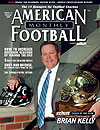Article CategoriesAFM Magazine
|
Q&A with Lou Tepperby: Mike KucharSenior Writer, American Football Monthly © More from this issue The name Lou Tepper has been synonymous with defensive football. Considered one of the original gurus of linebacker play, Tepper has coached over 20 professional linebackers including the likes of Dick Butkus Awards winners and NFL standouts Kevin Hardy, Dana Howard and Simeon Rice while he was the head coach at the University of Illinois. Since being named head coach in 2006 at Indiana University of Pennsylvania, Tepper is enjoying a resurgence at the Division II level. The Crimson Hawks defense finished last season among the top five nationally in three separate categories- rushing defense (76.1 ypg), total defense (235.70 ypg) and scoring defense (11.4 ppg). You canít play linebacker for Lou Tepper without knowing how to tackle. Heís spent his thirty-plus years of coaching shaping and honing his abi....The full article can only be seen by subscribers.
|
|
|||||||
| HOME |
MAGAZINE |
SUBSCRIBE | ONLINE COLUMNISTS | COACHING VIDEOS |
Copyright 2025, AmericanFootballMonthly.com
All Rights Reserved





